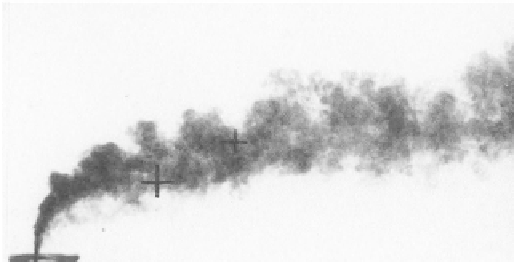Environmental Engineering Reference
In-Depth Information
where
L
M
,
L
Q
, and
L
b
are length scales (l) defined by
the following relations:
effluent momentum, and the plume motion can be
expected to be dominated by ambient currents rather
than buoyancy. On the other hand, when
L
M
/
L
b
<< 1, the
plume buoyancy becomes an important factor in plume
dilution, in advance of the ambient currents dominating
plume motion. For many ocean outfalls,
L
M
/
L
b
is suffi-
ciently small that these plumes are either buoyancy
dominated over the entire depth, where
y
/
L
b
<< 1, or
influenced by both buoyancy and ambient currents,
where
y
/
L
b
>> 1. These regimes are commonly referred
to as the
buoyancy-dominated near field
(BDNF) and
buoyancy-dominated far field
(BDFF), respectively. The
BDFF regime is sometimes referred to as the
advected
thermal
regime (Tian, 2004b; Wright, 1977a). lee and
Neville-Jones (1987) suggested the following formulas
for horizontal plume discharges in unstratified ambient
seawater:
Q
M
π
0
L
Q
=
=
D
(9.9)
1 2
/
2
0
M
B
3 4
/
0
L
M
=
(9.10)
1 2
/
B
u
a
0
3
L
b
=
(9.11)
The length scale
L
Q
measures the distance over which
the port geometry influences the motion of the
plume, the length scale
L
M
measures the distance over
which the initial momentum is important, and the length
scale
L
b
measures the distance to where the ambient
current begins to become more important than the
plume buoyancy in controlling the motion of the plume.
The length scale
L
M
is sometimes referred to as the
jet/
plume transition length scale
, and
L
b
is sometimes
referred to as the
plume/crossflow length scale
. In practi-
cal terms, if
x
is the distance along the plume centerline,
then the port geometry influences plume dilution where
x
<
L
Q
, specific momentum flux controls plume dilution
where
L
Q
<
x
<
L
M
, specific buoyancy flux controls
plume dilution where
L
M
<
x
<
L
b
, and ambient cur-
rents control plume dilution where
x
>
L
b
.
Defining the plume dilution,
S
, by the relation
5 3
/
y
L
y
L
C
,
1
(
BDNF
)
(9.15)
BDNF
SQ
u L
0
2
b
b
2
y
L
y
L
a
b
C
,
1 (
BDFF
)
(9.16)
BDFF
b
b
A laboratory snapshot of a plume with significant
ambient flow is shown in Figure 9.6. Values of
C
BDNF
and
C
BDFF
found by various researchers are given in Table
9.2, where the variability in these values are primarily
influenced by the location at which the dilution was
c
c
e
(9.12)
S
=
the functional relationship given by Equation (9.8) can
be expressed in the form
SQ
u L
L
L
L
L
y
L
0
2
M
M
(9.13)
=
f
,
,
4
a
b
Q
b
b
In most sewage outfalls, the port geometry has a rela-
tively minor influence on the near-field dilution of the
effluent plume. Under these circumstances, the dilution
becomes insensitive to the value of
L
Q
, and the func-
tional expression for the plume dilution, Equation
(9.13), becomes
Figure 9.6.
Single plume with ambient flow.
Source
: Wright
(1977b).
TABLE 9.2. Dilution Coefficients for Single Plumes
SQ
u L
L
L
y
L
0
2
M
=
f
,
(9.14)
Source of
Data
5
a
b
b
b
C
BDNF
C
BDFF
Reference
-
0.41
laboratory Chu (1979)
This relationship can be further reduced by considering
the physical meaning of the length scale ratio
L
M
/
L
b
.
When
L
M
/
L
b
>> 1, the ambient currents overwhelm the
plume buoyancy before the buoyancy overwhelms the
0.31
0.32
Field
lee and Neville-Jones (1987)
0.26
-
laboratory
Tian et al. (2004a)
-
0.25
laboratory Wright (1977a)


















Search WWH ::

Custom Search